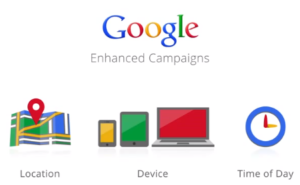NEW CAPABILITIES, NEW LIMITATIONS OR BOTH?
The easy answer … both. But following Google’s announcement about the new enhanced campaigns, the final answer can’t yet be determined. What’s my opinion? It’s going to take quite a bit of work for marketers and companies that are currently extensively active and efficiently optimized for all devices on Google AdWords to transition to the new campaign structure. However, small/medium businesses and late-adopters that have remained dormant in mobile marketing can dramatically improve their SEM. 
DEVICE, LOCATION & TIME-OF-DAY…
So for starters, Google is striving to position enhanced campaigns for everyone involved. Today, people are expressing their interests and intent through online searches, and we are connected in places that we have not been historically. During these searches for restaurants, stores, sports facts, celebrity images — you name it, people are constantly using different devices according to where they are and the time of day. Google has created a flexible way for marketers and advertisers to reach consumers, making it easier to promote marketing messages based on people’s context such as:
- What device they are using to search (smartphone, tablet or desktop)
- Their location while they are searching
- And the time of day their search occurs
DEVICE
Connectivity across different devices is now more accessible than ever. And to me, Google’s enhanced campaign is an effective adjustment that’s attempting to react to this increased connectivity. Consumers around the world are digesting more content from more devices, and Google wants to make reaching these people even easier. They explain, “Advertising plans that used to require separate campaigns, like ones that required bidding differently by device or location, can now be handled in a single enhanced campaign, making it easier to reach users no matter where they are or what device they are on.” So, it sounds like a perfect fit right? Nothing’s that easy, my friends.
The big issue people have with the new changes is that Google now lumps tablets with desktop and laptop devices. This means that marketers can no longer specifically target tablets for their paid search campaigns, even though tablet purchases and usage continue to skyrocket. Based on what Google has discovered throughout their research, they determined that tablets aren’t mobile — at least in their eyes. However, some people disagree with the motives behind the changes. By pairing these two devices together, users should expect to see higher desktop CPCs, but more importantly even higher mobile CPCs. Cha-ching for Google, not so much for large companies.
LOCATION
Here comes Big Brother. With the new location services, marketers have more choices on how you want to target consumers according to where they are. With a single campaign, marketers can utilize multiple bid modifiers. For example, you can bid 75 percent higher within a half-mile radius, 50 percent higher within a 10-mile radius and even reduce your bids outside of 30 miles. For companies using paid search, this is the most beneficial of the major adjustments by Google, once you get past the creepiness of Google marketers knowing where you are at all times.
TIME-OF-DAY
As advertisers and marketers know, timing is everything. And because of that, Google improved targeting for everyone with the last of their big three AdWord changes. Now, ads can be served during normal business hours for a retailer, morning breakfast hours for your local coffee shop or whatever day-part fits best with the content that is being searched for. This is another great advantage, because nobody wants their AdWords budget dollars disappearing at 2 a.m.
WHAT IT ALL MEANS
By the time enhanced campaigns are forced into replacing everyone’s legacy campaigns, don’t expect immediate results across the board. While the changes are designed to respond to the always-on, mobile device world of today, this new process for segmenting and fine-tuning will take longer for some marketers. It’s not quite an “extreme makeover,” but it does qualify as quite a facelift for AdWords — especially with the improved mobile metrics like call analytics and measurable click-to-call buttons. My stance? It’s about winning on mobile, mobile and more mobile. By delivering smarter ads optimized for varying user contexts and building advanced reports to measure new conversion types, Google has made their big move toward utilizing powerful marketing tools for the multi-device world of today.
What’s your reaction to the new enhanced campaigns?